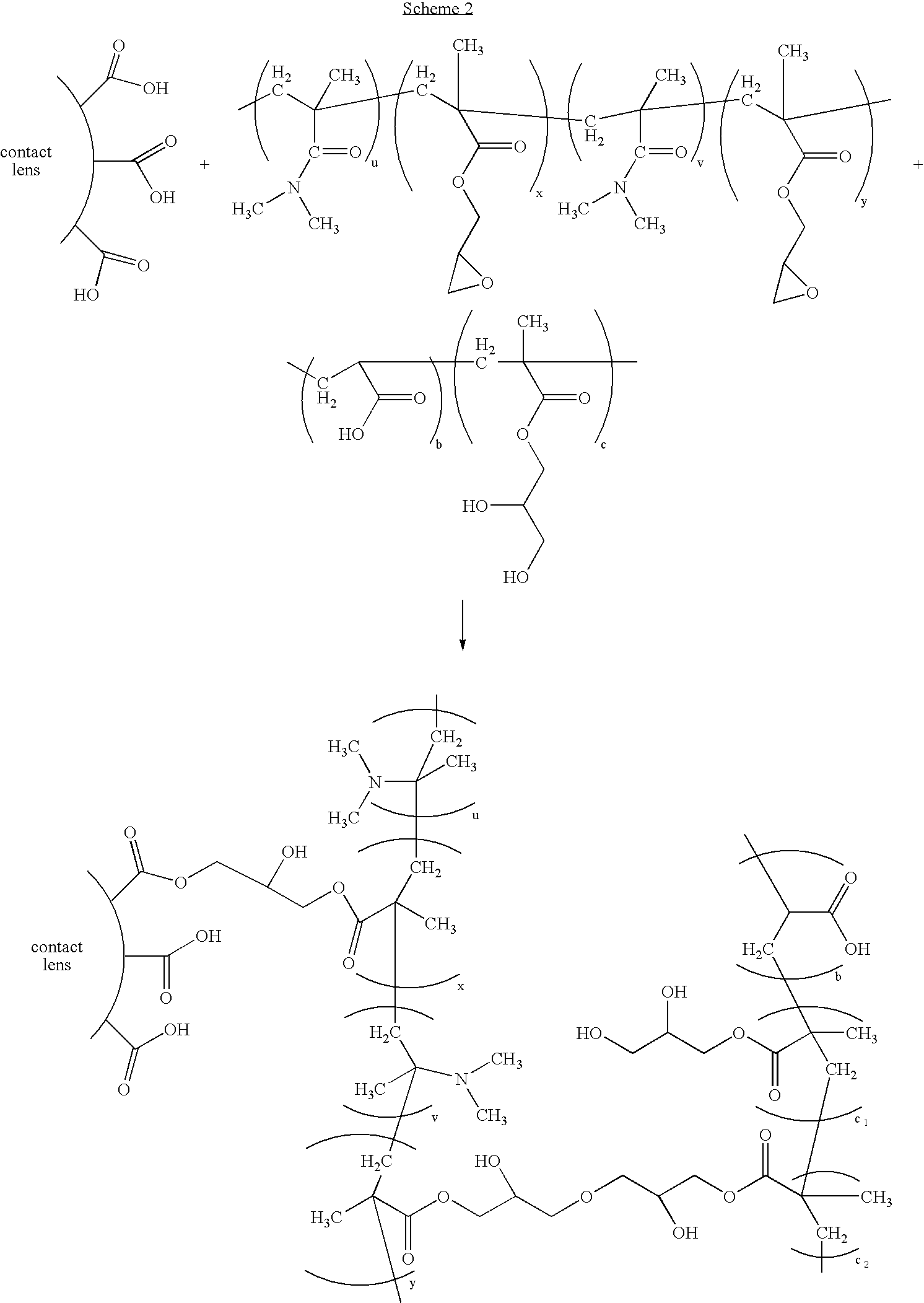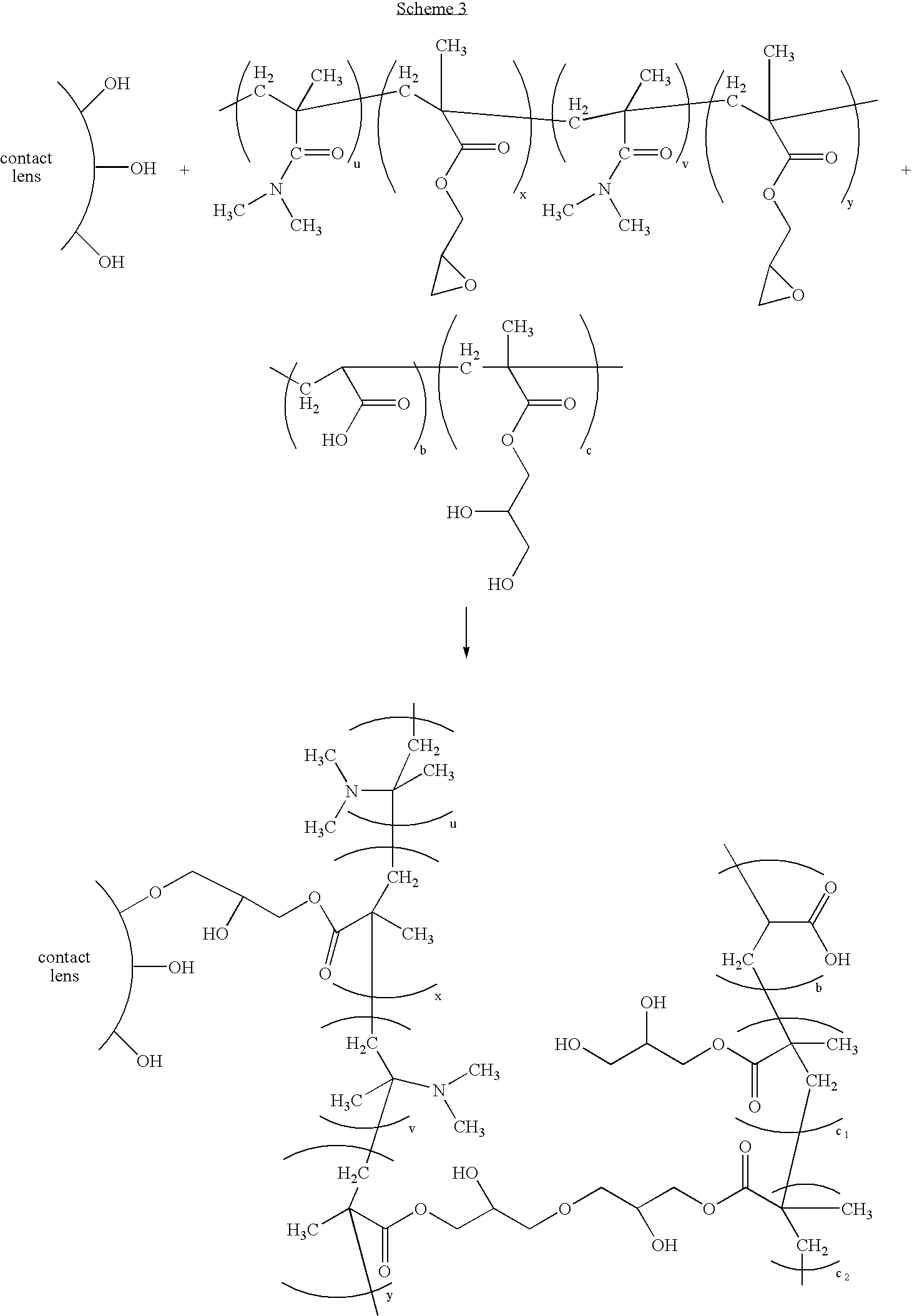Polymers comprising polyhydric alcohols, medical devices modified with same, and method of making
a technology of polyhydric alcohol and polyhydric alcohol, which is applied in the field of polyhydric alcohol, can solve the problems of affecting the clarity of the lens and the comfort of the wearer, and the plasma treatment process, which requires a significant capital investment in plasma processing equipment, and achieves the effect of reducing the dehydration rate and increasing the surface lubricity
- Summary
- Abstract
- Description
- Claims
- Application Information
AI Technical Summary
Benefits of technology
Problems solved by technology
Method used
Image
Examples
example 1
Preparation of Copolymer of Glyceryl Methacrylate and Acrylic Acid
[0088] A 250-ml three-neck flask was equipped with a stirrer and a condenser. The flask was immersed in an oil bath. Into this flask were added 100 ml of deionized water, 6.207 g (or 38.75 mmol) of glyceryl methacrylate, 1.385 g (or 19.22 mmol) of acrylic acid and 0.090 g (or 0.55 mmol) of AIBN polymerization initiator. The contents of the flask were bubbled with nitrogen vigorously for 20 minutes while under stirring, then the nitrogen flow was turned to a lower rate. The contents of the flask were heated to and kept at 70° C. under nitrogen purging for two days. The copolymer was saved as a 3% (by weight) solution in deionized water.
example 2
Lens Casting of Polyurethane-Siloxane Hydrogel Formulation
[0089] Monomer mix consisting of 14D6S5H (further described below) / TRIS / NVP(N-vinyl pyrrolidone) / DMA / HEMAVC (HEMA vinyl carbamate) / n-hexanol / Darocur™ 1173 (a photopolymerization initiator) / lMVT (1,4-bis(2-metharylamido)anthraquinone, providing a blue tint) at weight ratio of 60115 / 22 / 7 / 2.511 / 10 / 0.51150 ppm was made. I4D6S5H is a prepolymer having a formula of HEMA-IPDI-(PDMS5000-IPDI-DEG-IPDI)4(PDMS5000-IPDI)2-HEMA, wherein IPDI is isophoronediisocyanate, PDMS5000 is polydimethysiloxane having a molecular weight of 5000, and DEG is diethylene glycol. The mix was used to cast lenses using polypropylene molds. Lenses were released from the molds, extracted with isopropanol overnight, and then placed in deionized water.
example 3
Surface Treatment with Copolymer of Glyceryl Methacrylate and Acrylic Acid
[0090] An aqueous solution containing 3 weight percent of the copolymer produce in Example 1 was prepared. Lenses from Example 2 were placed in vials containing this solution and then autoclaved for one thirty-minute cycle. Five lenses from Example 2 were also autoclave in deionized water. After autoclaving, the lenses were inspected for wettability. Lenses treated with the copolymer solution were found to be more wettable and lubricious than those that were untreated or treated only with deionized water. When the lenses treated with the copolymer solution were placed in borate buffered saline, they became qualitatively even more wettable and lubricious, as judged by rubbing.
PUM
| Property | Measurement | Unit |
|---|---|---|
| contact angle | aaaaa | aaaaa |
| contact angle | aaaaa | aaaaa |
| contact angle | aaaaa | aaaaa |
Abstract
Description
Claims
Application Information
 Login to View More
Login to View More - R&D
- Intellectual Property
- Life Sciences
- Materials
- Tech Scout
- Unparalleled Data Quality
- Higher Quality Content
- 60% Fewer Hallucinations
Browse by: Latest US Patents, China's latest patents, Technical Efficacy Thesaurus, Application Domain, Technology Topic, Popular Technical Reports.
© 2025 PatSnap. All rights reserved.Legal|Privacy policy|Modern Slavery Act Transparency Statement|Sitemap|About US| Contact US: help@patsnap.com



